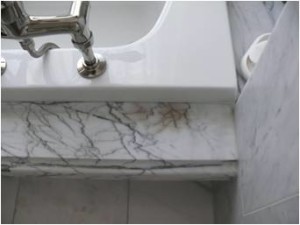 When that elusive marble stain has escaped your best cleaning and polishing efforts then it’s time to pull out the big guns with a marble poultice.
When that elusive marble stain has escaped your best cleaning and polishing efforts then it’s time to pull out the big guns with a marble poultice.
Making your own poultice or buying a pre-mixed poultice to remove stains is easier than you may think.
A poultice is a liquid cleaner (like pH balanced dish-washing liquid), water or a chemical (i.e., hydrogen-peroxide) mixed with a white absorbent material to form a paste about the consistency of putty or peanut butter.
The paste should be thick and smooth enough to spread but not so thin that it runs.
 TIP: The type of liquid you mix with the white absorbent material will depend on the material you choose — only combine liquid and powder to the consistency of PASTE.
TIP: The type of liquid you mix with the white absorbent material will depend on the material you choose — only combine liquid and powder to the consistency of PASTE.
The poultice is spread over the stained area to a thickness of 1/4 to 1/2 inch with a wood or plastic spatula (no metal), covered with plastic food wrap and left to work for a minimum of 24 to 48 hours. A poultice can also be spread using white cotton balls, white paper towels, gauze pads — or even your fingers.
The paste will draw out the stain into the absorbent material. (Think cat litter on an oil stain on your garage floor) Poultice procedures may have to be repeated to thoroughly remove the stain. Depending upon the stain type, some may not be completely removed but will return an improved appearance.
CAUTION: More than two or three poultice applications over the same spot to remove a stain may etch the stone. If the stain does not come out after two to three poultice attempts and/or no improvement is noted, you should consult a professional.
Marble Poultice Materials and Where to Buy Them
There are many natural products used in making a poultice at home. Some of these materials include kaolin, Fuller’s earth, whiting, diatomaceous earth, powdered chalk, talc and white molding plaster. What these are and where you can find them are below.
TIP: Approximately one pound of prepared poultice material will cover one square foot.
CAUTION: Do not use whiting or fuller’s earth iron-type with acid-type chemicals. The chemical reaction will cancel the effect of the poultice.
Kaolin – This is a soft white clay used in the making of porcelain and is also used in the making of paper, rubber, paint and many other products. It can be found at online retailers or ceramic pottery supply houses. This is not generally available from large hardware chains.
Fuller’s earth – This is a clay-like earthy material that is used as an absorbing agent. Interestingly, almost 70% is mined mainly in the southeastern United States. This is readily available from online retailers.
Whiting – This is a calcium carbonate de-greaser. You can find this online and also at stained glass supply houses. This is generally not available at a hardware store or big box retailer.
Diatomaceous earth – This is a soft, siliceous sedimentary rock that is easily crumbled into a fine white powder. It’s used in pest control products, to help clean outdoor swimming pools and a number of other applications. This is found in hardware stores, through pool cleaning companies and at online retailers.
Powdered Chalk – This is used for marking boundary lines in sports fields, sidewalk or marker board chalk and even included in toothpaste. It readily available at arts and craft stores, online retailers, and most hardware stores.
Talc – This is a mineral, produced by the mining of “talc” rocks and then processed by crushing, drying and milling. It’s used for its absorbency in a number of products. Talc powder is available through online retailers.
White molding plaster – This a common material and is the powdered form of gypsum used in drywall, casting for art objects, casts for broken bones and a number of other uses. This is readily available at online retailers, drywall suppliers, crafts stores and hardware stores.
When Using a Marble Poultice Remember This
- Always test in a small inconspicuous area first before applying to a larger stain
- When mixing hydrogen peroxide with dry ingredients, as recommended on many websites, know that hydrogen peroxide will cause your marble to darken slightly. This is not something you want to use on Carrara marble
- Let a marble poultice completely dry before removing it
- A poultice can easily be removed with warm, soapy water — exercise a little patience in removal and do not scrap the poultice off as you may scratch the marble surface
- The poultice will, at a minimum lift the bulk of a stain, but is no guarantee of complete removal for those marble stains that are aged or deep-seated — this may require the services of a professional
- Be sure to wet the marble’s surface with water BEFORE applying the poultice — this will ensure optimal distribution and absorption of the marble poultice




